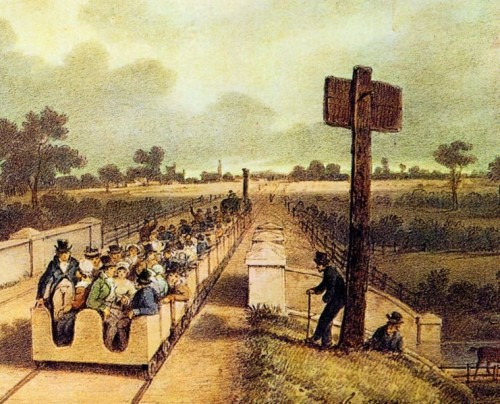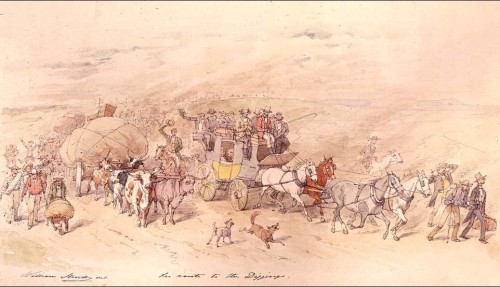It is difficult to imagine life before cars, trucks, motorbikes and aeroplanes. Those who came to Australia during the gold rush however, travelled here, explored the place, and moved huge quantities of cargo long before the car, truck, motorbike and aeroplane were invented. How did they do it?
Let’s examine the journey of an imaginary gold miner who we will call Mr Yuilisses, or Mr Y for short, to better understand 19th century transport technologies.
The year is 1852. Like many well-educated young men, Mr Y has decided to try his luck on the Australian goldfields. He lives in the UK in the “cottonopolis” of Manchester, the first industrialised city in the world, where he has been studying canal engineering. The first part of his trip involves taking a train west to Liverpool (the Liverpool to Manchester Railway, opened in 1830, was the first intercity passenger rail line in the world). He says goodbye to his parents, who he is unlikely to ever see again, as for the majority of gold rush immigrants to Australia, this was a one way trip (Serle, The Golden Age, 1977, p. 382). He then boards a noisy, dirty, uncomfortable steam train. He decides not to get a first class ticket as he is saving his pennies for gold mining supplies. The train is still 5 times faster than getting to Liverpool by horse (Nicholson, Steam, Steel and Speed, 2008, p. 7). This relative ease of movement makes Mr Y very grateful for the Industrial Revolution!

Opening Liverpool and Manchester Railway, 15th September 1830. Most train carriages had roofs by 1852, but they weren’t much more comfortable than this.
After a freezing, windy journey in an open carriage he alights at Crown Street Station in Liverpool. Next, he has to organise a ticket for a ship to the Antipodes (Australia). He decides to travel on a “clipper” – a very fast, yacht-like sailing ship – and gets his equipment for the long journey in order. While basic rations (food/water) are part of the ticket price, Mr Y needs to take clothes and his own bedding. If he were a woman and mother he would probably think to take some seeds or fruit tree seedlings to make sure his family are fed once they settled on the goldfields. However, Mr Y is going by himself, so he is more focused on gold than food and knows there will be plenty of mutton to be eaten in the new state of Victoria (only made separate from NSW in 1851). After all, until gold was “discovered” (by non-Aboriginal people) in 1851, Victoria’s main export was wool from the 5 million sheep farmed across the state.
If Mr Y were extremely lucky, the clipper would take him from Liverpool to Melbourne in as little as 3 months. If he bought the cheapest ticket – in steerage, below the waterline at the very bottom of the ship – he not only risked his life through exposure to unhygienic conditions, but also a lack of air and potentially days of total darkness if the weather turned bad. Rarely were people in steerage class allowed to use candles or oil lamps in their highly flammable environment, even when the hatches were battened down (the openings in the deck for ventilation/sunlight were closed during storms). Buying a first class ticket didn’t make the journey much more comfortable. Read more about the horrendous conditions on 19th century sailing ships here and here.
When Mr Y arrives in Melbourne having survived his trying journey via the Great Circle Route (one of the most dangerous parts of which was Victoria’s Shipwreck Coast– where 638 ships are known to have sunk!), safe and scurvy-free thanks to all of the lime juice he drank and pickled cabbages he ate (an idea of British Navy surgeon James Lind), everything in 1852 Melbourne costs a fortune! A bed for the night, supplies to take to the goldfields, even the cost of clean water was a rip-off… Of course the reason these “goods” (products) were so costly, was because most had made the long, expensive journey from the UK to the Australia just as he had. Little did Mr Y know such things were even more expensive on the diggings! Once he had stocked up on tent canvas, a mattress, a shovel, gold pans and a wheelbarrow, he would investigate how to get to Ballarat, and if indeed that was a good goldfield to venture to. In 1852 there was much talk among the people at the port that Ballarat’s gold had run out, and that the Bendigo Creek was a better bet. But who could you trust for such advice? If he selected Ballarat the journey could be shortened by taking a “steamer” (boat) from Melbourne to Geelong, which only takes half a day and shaves 3 days off the walk, but again the tickets were quite expensive.
Our brand new, inexperienced gold miner Mr Y decides to head to Ballarat after all, and early the next morning he sets out with many others making the same journey. His expensive mattress becomes waterlogged after a big storm on the first day of the 113km walk, so he decides to abandon it along with the hundreds of other pieces of broken, spoiled, or foolishly heavy equipment others before him have dumped along the way. He wishes he had paid the ridiculous price to travel by wagon (or at least have his belongings sent by bullock dray) but the price was far too high. He had heard that the journey by wagon is so bumpy that most people end up walking anyway, as the jarring motion of the wagon makes many “seasick”.
While there is no actual road to the diggings of Ballarat, there is already a well-worn path that takes Mr Y past beautiful eucalypt forests, the likes of which he has never seen before. It takes him over hills and creeks (which he has heard are sometimes so deep and dangerous on the road from Geelong to Ballarat that you have to pay the local Aboriginal People to make bark canoes to get your mining gear across), and eventually he arrives within earshot in Ballarat on day 3 of his journey. He can barely sleep for all of the exciting noise he can already hear coming from the goldfield, now little more than a few miles (kilometres) away. If he had approached Ballarat from Geelong he would be staying in Mother Jamieson’s Inn just south of Mt Buninyong (in 1849 this was the “the busiest town in Victoria outside Melbourne and Geelong”), but instead he’s sleeping under the stars (close to the town we now know as Ballan), yet again.

William Strutt, En route to the diggings, pencil and watercolour, 1851. Reproduced with the permission of the Victorian Parliamentary Library.
Mr Y finally arrives at the Ballarat diggings, and looks in wonder at the tent city in front of him, bursting with adventurers from all over the world. He lives in a tent for the first few months, then a slab hut, and then, once he finds a large gold nugget, he builds a house and gets married. Up until this point, his only means of transport around Ballarat has been his own two feet, but now he can afford to buy a horse to help with his mining work and deliver his children to school.
Horses were incredibly useful on the goldfields for both transport and work. Apart from being used to move people and cargo, they could also be attached to whims, Chilean mills and puddling machines to extract gold from mud, clay and rock. However, horses are dangerous, and back then were responsible for many deaths and injuries, and are still the most likely animal to kill you in Australia! In the 1860s, camels were imported to Australia for Burke and Wills ill-fated expedition, but there weren’t any in Ballarat at this time. As far as we know Ballarat has never had a resident camel!
After an exciting life of adventure, pioneering, and hard work to secure his family’s comfort, let’s imagine Mr Y dies in 1885, one year before the first car was invented. His great-grandchildren living in Ballarat would become the first of his descendants to own cars, as cars didn’t become popular and affordable here in Australia until well into the 20th century.
Links and References:
Sovereign Hill Education: Transport in the 1850s, Research Notes for secondary school students: http://education.sovereignhill.com.au/media/uploads/sovehill-pdf-file/SovHill-transport-notes-ss1.pdf
Horrible Histories on the pioneers of transport: https://www.youtube.com/watch?v=NLL2Txs8kCg
SBS Gold on goldrush transport: http://www.sbs.com.au/gold/story.php?storyid=18
Clipper ship routes and records: http://en.wikipedia.org/wiki/Clipper_route
A fantastic blogpost about 1850-1870 ocean journeys to Australia: http://museumvictoria.com.au/discoverycentre/websites-mini/journeys-australia/1850s70s/
Another which is terrifying!!: http://museumvictoria.com.au/discoverycentre/websites-mini/journeys-australia/1850s70s/privies-and-hygiene/
“See the Land from an Aboriginal Canoe” – Aboriginal bark canoe technology was in high demand in the 1800s: http://www.cv.vic.gov.au/stories/aboriginal-culture/seeing-the-land-from-an-aboriginal-canoe/seeing-the-land-from-an-aboriginal-canoe/
Is your train commute quicker now than it was 100 years ago? http://www.theage.com.au/victoria/is-your-train-commute-quicker-than-90-years-ago-the-answer-might-surprise-you-20150219-13gx1c.html
The history of Australian immigration: http://museumvictoria.com.au/discoverycentre/websites-mini/immigration-timeline/
Website on the last surviving clipper ship, City of Adelaide: http://cityofadelaide.org.au/
An interesting article on scurvy: http://www.bbc.co.uk/history/british/empire_seapower/captaincook_scurvy_01.shtml
The introduction of cars to Melbourne: http://museumvictoria.com.au/marvellous/powered/car.asp
Henderson, W. F. and Unstead, R. J. Transport in Australia, A & C Black LTD., London, 1970.
Nicholson, John. Steam, Steel and Speed: Transport, Trade and Travel in Australia 1850s-1920s, Allen & Unwin, NSW, 2008.
Serle, Geoffrey. The Golden Age: A history of the colony of Victoria 1851-1861, Melb. Uni. Press, Vic, 1977.











Great story – thanks. Our family visited Sovereign Hill in 1985!
Our museum has grown quite a lot since then! We hope you get the chance to visit again one day 🙂
I’ve recently found out that my great great grandparents arrived via the Red Jacket. A TOTAL surprise …
Thanks for the image, which brings it all to life